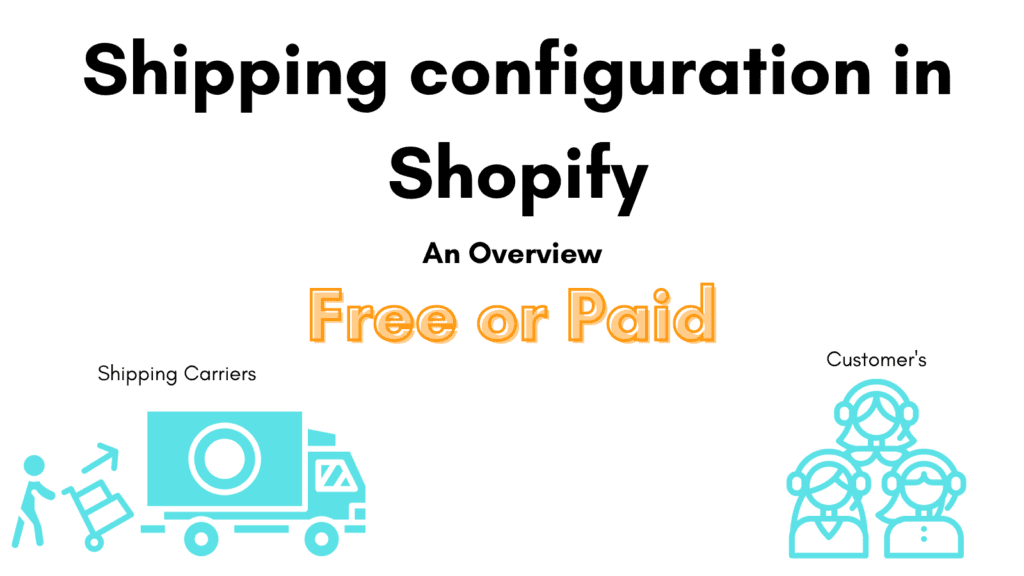
Shipping is one of the greatest solutions that every ecommerce brand has been blessed with.
Neither customer nor brand has to leave their house to get something new from the market.
Nowadays, we’re just one click away and the product will be delivered to our location safely and fastly. All thanks to the shipping mechanism and their efficient hardwork.
But somebody has to pay for this convenience either brand itself or customer or both.
As shipping costs are among the top reasons that influence a customer’s decision of placing an order, it becomes super important to have an effective and customer friendly shipping strategy. Doing this you may experience a significant boost in conversation rates.
What is shipping and what it involves ?
The moment someone places an order on an online store shipping mechanism gets activated.
You may have noticed – after placing an order a form appears where you’re asked to fill out your contact info, delivery address and other relevant details. This is the actual beginning of the shipping process which remains in effect until the product is safely delivered to the customer.
It ensures that the product is delivered to the right customer on the right time at the right place in the perfect condition.
When all these pieces are executed properly customers trust on the brand increases. Once the customer is happy with the service he may keep ordering from you again and again or can even pull more customers especially his relatives and friends through word of mouth.
In short, Good Shipping ➡️ Customer Satisfaction ➡️ Increase Brand Credibility ➡️More Customer’s get attracted organically.
Imagine yourself as a customer who’ve ordered a Nike shoe and unfortunately received Adidas or received the right brand but of different colour from which you’ve selected or there’s an issue in the size. How will you feel?
Obviously, this kind of tragedy will definitely create a negative impact on you. As a result, in future you’re less likely to purchase anything from there.
What’s more bitter is the negative promotion through word of mouth. Frustrated customers are like bad hallmarks, they will surely spread negative awareness in their surroundings based on their bad experience- causing a negative reputation in the market. All thanks to the poor shipping process.
Before you begin setting your shipping and delivery mechanism few things must be clear
- Target location
Where you are going to sell/ship your products —is it native country or another country. So select zones accordingly.
- Shipping charges
Are you going to offer free shipping? If not, then how much are you going to charge for shipping from customers?
Be sure to adjust your shipping rates according to shipping zones so you can enjoy decent profit margin.
Step-by-Step Guide to Configure Shipping Settings in Shopify
Accessing Shipping Settings
Head to your Shopify store and click on the setting option from the left bottom corner.
From setting window click on the shipping and delivery tab on the left hand side
Here, you will see the option to configure shipping mechanisms for your brand such as shipping rates, delivery methods, and zones.
Setting Up Shipping Zones

Shipping zones are the regions where you are going to ship the products. i.e., the starting point of delivery to its destination.
For different zones, you can set different shipping rates depending on the location, distance, product weight, or price.
For example: let’s say your brand’s native location is the USA, where you are offering free shipping in Zone 1, where delivery distance is very minimal, and enjoying a good profit margin, but this won’t be the same if you start offering free shipping in Zone 8, where delivery distance is farthest.
An increase in delivery distance consequently increases the overall expenses; therefore, to cover these addon expenses, you can charge shipping rates in Zone 8, whereas in Zone 1, you can keep it free
Please be aware that delivery charges may change when planning to target International countries.
Custom duties and other taxes are something you have to consider while setting up shipping rates.
Creating and Managing Shipping Zones
For creating and configuring zones, click on the manage rate option, where you will get the option to create shipping zones as well as edit existing zones, rates, and conditions.
Just click on the create shipping zone option, and a list of the countries will appear. Choose one where you want to sell your products. Here, we will go with the USA as our domestic country.
As we choose the USA; all the states within the USA will be disclosed; you can select all of them or exclude those where you do not want to sell the products.
Adding Shipping Rates

Well, there are two options available: you can either set your own rates or use a carrier to calculate rates in real time.
Then you’ll ask to share, in how many working days the product will be delivered. This information will be shown to the customer after the product is ready to ship.
Next, you can decide the optimal price to be set as a shipping charge. For this, it would be great if you did some research and calculations to get the most reasonable rate for your targeted shipping zone.
And then you can set the conditions for when these rates are going to apply.
Let’s check the second option that is using carrier rates in quickly. What does it include?

Carrier rates aren’t set earlier, but they’re automatically generated in real-time based on the destination distance, weight, and size of the product. You can simply choose the carrier from the given list, and of course, the best one.
Setting conditions for shipping rates
What are conditions?
Conditions in the shipping context mean setting some rules for when you are going to charge for shipping and when not.
Shopify provides two types of conditions that we can set.
- Weight-based conditions
- Price-based conditions
In weight-based conditions, when customer purchase any product whose weight is more than 1 kg (the value can be customized), then only cutomer have to pay for shipping; otherwise, he can enjoy free shipping.
The same goes with price-based conditions. After a customer purchases the product whose price is more than the price you have set as a condition limit, then only he will be paying for shipping; otherwise, he will not.
Types of shipping rates
Who doesn’t like free shipping? Everyone does.
Free words are customers’ favorites. And offering free shipping is the best way of enticing the prospect to buy something.
his may increase the conversion rate, and it is the easiest trick you can apply.
But, Not every e-commerce owner can offer it due to running expenses that have to be covered, such as career costs, customs duties if applicable, marketing costs, and other taxes.
Instead of asking for shipping charges directly you can just combine the cost of shipping with the price of the item and sell it to the customer.
For example
original price of the item ($40) + shipping cost ($10))
The total will be $50. Now you can sell at this combined price by advertising free shipping. After this, it’s better and more ethical not to collect any extra penny from customers, as technically you’re already in profit. If this doesn’t sound great, you can keep your charges transparent.
In my opinion, charges won’t affect sales that much. If your product is of high quality, then customers will readily pay more than what you’ve asked for.
So focus on giving the best rather than worrying too much about mathematical calculations.
Top Shipping carrier for ecommerce business I would like to share
USPS
Covers almost every corner of the United States. If you are specifically targeting the USA this can be a great choice. Plus, it also offers shipping to 180 countries, offering a wide range of services like first-class mail, priority mail, and so on.
UPS
It also offers domestic and international shipping and is among the top carriers in the world.Provides advanced tracking solutions and timely services.
FedEX
Has a great supply chain network globally. And it has delivered around 14.5 million parcels till now. Known for its speedy and premium delivery, it also offers great logistical services.
DHL
Based in Germany, it provides international courier services and offers great logistics, transportation, and tracking systems.
Additional resources
The beginner guide to Shopify shipping settings an YouTube video tutorial by Michelle Bali shares a clean process of how to configure the shipping mechanism for store.






